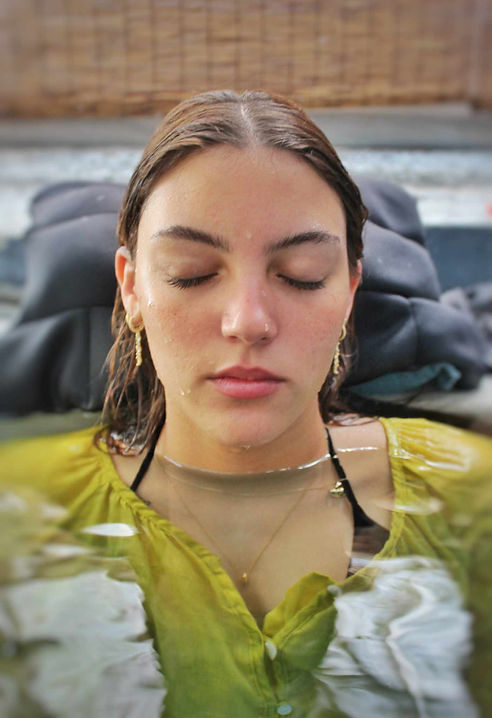התנועה כתרופה
מאת אלכסנדר ג'ורג, ממציא שיטת הילינדאנס
למערכות הגוף יכולת לרפא את עצמן. השפעות חיצוניות יכולים להיות לעזר או להפרעה
על הגוף והנפש, אבל ריפוי יכול לבוא רק מבפנים. מערכת היחסים בין
.המדריך והאורח נמצאים במסגרת של אמון ומכוון לתת לריפוי הפנימי הזה לקרות
תנועות במהלך הטיפול הם כמו הצהרות, פתיחת דלת שדרכה המטופל
בוחר לנוע קדימה. ריקוד הריפוי, אם כן, הוא האינטראקציה בין המדריך
.והאורח, בין חמלה לפחד, בין התנועה לבין האנטרופיה
אפשר להבין את התנועות כגילויי גוף, ולחוות חופש
וקלות אפשרית, בגוף הנפש מהדהדת את "דפוס השלמות" האבוד
הריקוד הוא בין המסר תת הכרתי בתוך התנועות והוא משדר
.את רמות העומק של המודעות
האמונה בכוח הריפוי של התנועה היא הבסיס לטכניקה זו
התנועה היא
. (dosed)נעשית בהקשבה. אם התנועה היא תרופה. יש חשיבות למינון
המדריך בהקשבה לאורח בוחר מה הקצב הנכון וכמה לתת. אינטרוולים של
דממה באופן טבעי מהווים חלק מתפיסת המינון. בפיתוח שלנו וביומיום
.החיים, חלקים מאיתנו הופכים מבודדים אנרגטית
לתנועה ולריקוד יש את הכוח להמריץ מחדש, לפוגג חסימות, להתחבר מחדש ולאזן,
.כדי לשחזר תחושה של שלמות
כוחו של ריקוד יכול לשנות תנאים רבים
המדריך נוכח לתגובות הגוף והוא יודע לקרוא סימנים, חיוך צחוק ודמעות נעים כולם באותו כיוון, .בחזרה לשלמות
.האחריות המוטלת על המדריך היא בתשומת הלב וכבוד. מאחורי התנועה עשויה לעלות מודעות.
.בחווית ההילינג דאנס והטיפול במים, עולה הנאה הקשורה לעיתים קרובות עם יופי.
.בחוויית היופי המטופל חווה חסד, כוח, עדינות, חופש חוסר משקל ורגישות במה שאפשר לכנות ריקוד "פאסיבי".
המטופל חווה את עוצמה ביופי, והיופי הוא ביטוי אלוהי.
הנוכחות של היופי מרוממת. נוצר פתח מחדש לערוץ של אושר. במסורת הרוחנית ההודית, האושר מצב טבעי של תודעה. "Satchitanand" פירושו "האמת היא התודעה של
אושר ", בהיותנו זוכרים את אושרנו כמצב ההוויה האמיתי שלנו הוא לקח רב עוצמה, לא צריך
.רק ללמוד באמצעות סבל וכאב
אדם צריך מידה מסוימת של ביטחון
עם זאת, לפני שרגשות כואבים עולים על פני השטח. החוויה של ברכה וחסד
.תאפשר לתת להן ביטוי כמראה ספונטנית
Movement as Medicine
Living systems heal themselves. The body and psyche can be helped or hindered by
external influences, but healing can only come from within. The relationship between
therapist and client is a setting of trust and intention for this inner healing to happen.
The movements of a session are as affirmations, open doors through which a client
chooses to move forward. The healing dance then, is the interaction between therapist
and client, between compassion and fear, between movement and entropy. The
movements could be understood as revelations to the body, showing what freedom
and ease are possible, resonating in the body-mind the lost "pattern of perfection" it
carries. The dance then is between the subliminal message within the movements and
the deeper levels of awareness of the receiver.
Belief in the healing power of movement is the basis of this technique. If movement is
medicine, then it must be dosed carefully. This entails allowing the right movement to
arise at the right moment, in the right rhythm, for the right duration. Intervals of
stillness naturally form a part of this dosing concept. In our development and in daily
living, parts of us become energetically isolated or distorted. The Shiatsu terms of kyo
and jitsu, denoting conditions of depletion and stagnation could apply to the total
person as well. Movement, or dance, has the power to re-energize, to break through
blockages, to reconnect and balance, to restore a sense of wholeness. The power of
dance can shift many conditions.
The therapist is on the lookout for reactions indicating key movements. Sighs, moans,
smiles, laughter and tears are all moving in the same direction, back to wholeness.
Whatever movements evoke them are significant, shedding light on the mystery of
self-distortion. A key movement may also arise from the receiver. In this case our
responsibility is to take note and to honor it. By giving it time to play out and even
encouraging it, the motivation behind the movement may surface into awareness.
In Healing Dance sessions, the reaction of pleasure has often to do with the
experience of beauty. It is beautiful to partake of grace, power, gentleness, freedom,
weightlessness and sensitivity in what could be termed passive "received" dance. The
receiver experiences herself as Beauty, and Beauty is a manifestation of the Divine. In
the presence of Beauty we are exhilarated, quickened, uplifted. Receivers not
uncommonly ascend to higher states of consciousness, re-opening a seldom used
channel to a state of bliss. In the Indian spiritual tradition, bliss is understood as the
natural state of consciousness. "Satchitanand" means "truth is the consciousness of
bliss". Remembering bliss as our true state of being is a powerful lesson; we need not
only learn through suffering and pain. The experience of even a moment of bliss can
trigger a reaction to its loss in our lives. A person needs a certain degree of security,
however, before painful feelings can surface. The experience of a bliss state can be
enough to allow their spontaneous appearance.

